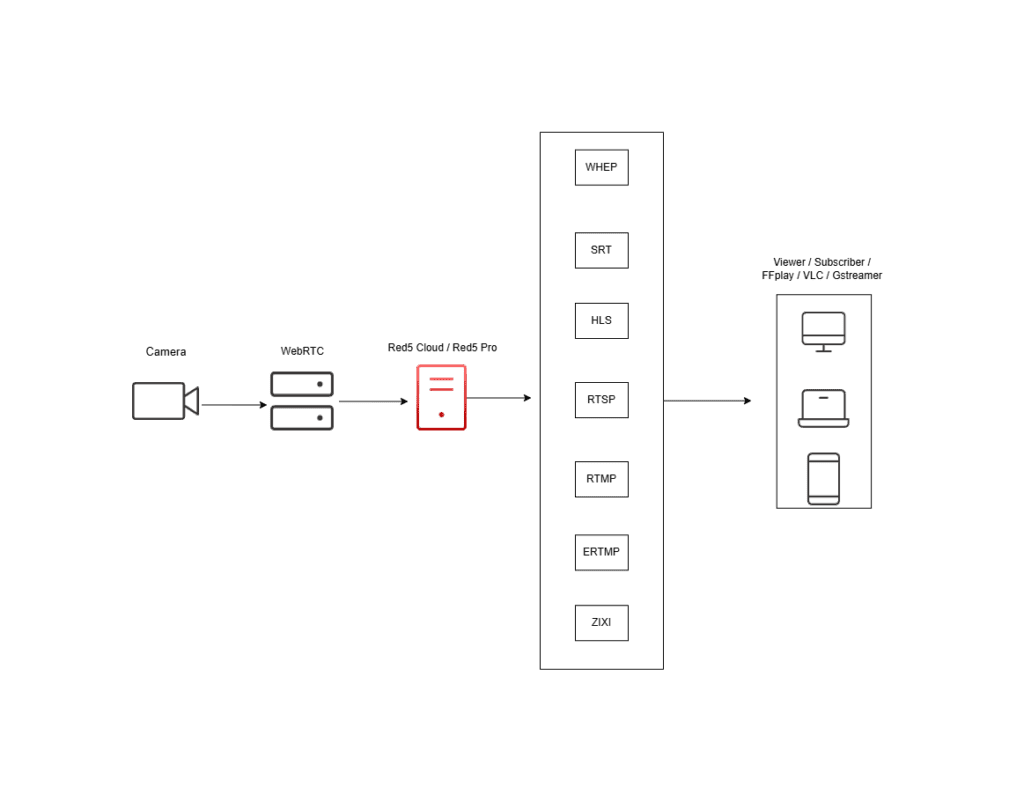WebRTC Streaming
Build real-time streaming applications powered by WebRTC streaming protocol with ultra-low sub-250 ms latency.
TRUSTED BY
What is WebRTC Streaming?
WebRTC streaming is the process of delivering live video in real time with ultra-low latency that powers interactive video experiences such as conferencing, gaming, and live events. WebRTC streaming is still king in 2025, enabling sub-250 ms latency for true real-time scenarios.
Red5 supports WebRTC streaming in Red5 Pro and Red5 Cloud. Check out our WebRTC demo to see it in action.

Deliver WebRTC Streaming with Red5
Live stream video, audio, and data using WebRTC protocol with sub-250 ms latency to millions of viewers using Red5 Pro or Red5 Cloud.
Easy To Set Up and Use
Get started quickly with detailed documentation and step-by-step video tutorials that make setup and configuration simple.
Transparent and Flexible Pricing
Start streaming for free today with Red5 Cloud or Red5 Pro.
Hands-On Support
We reply to your support inquiries via email, through private dedicated channels in the Slack community for developers, and by phone.
Customers need sub-second latency that scales across many industries.
Live Auctions, Surveillance, Sports, Media, Online Gambling, Government, Interactive Shopping
Red5’s WebRTC Server Features
Ultra-Low Latency
Deliver video, audio, or data with sub-250 millisecond latency across various devices, from smartphones to desktop browsers.
Scalability
Automatically scale from small deployments to global audiences based on demand.
Secure Streaming
Protect streams with AES-128/256 encryption.
Recording and VOD Capabilities
Record and store your live streams effortlessly for on-demand playback.
Compositing
Mix and arrange multiple video and audio feeds in real time using server-integrated mixers, choosing Brew for native performance or CEF for web-based flexibility.
Live Metadata Support
Send real-time metadata with your streams, including speaker names, song titles, scores, and captions, to power overlays, discovery, and interactive features.
Watermarking
Create a server-side watermarked stream to brand your content.
Server-Side Ad Insertion
Integrates with our patented SSAI technology for seamless monetization.
Analytics & Monitoring
Monitor your stream health, bitrate, frame rate, connection status, and latency with intuitive dashboards.
Closed Captioning
Enhance accessibility and engagement with real-time captions, ensuring your content reaches wider audiences anywhere, anytime.
Adaptive Bitrate
ABR adapts to network conditions and resends dropped packets for stable, high-quality audio and video even on congested networks.
Firewall-Friendly Connectivity
Simplify deployment with built-in NAT traversal and automatic handshake negotiation, enabling connections through most firewalls without manual configuration.
Multi-Browser Support
With Web Standard certified WebRTC, encode and decode directly in all modern browsers, plugin-free on any device.
Diagram showing how WebRTC streaming works

FAQs
/
What is WebRTC?
WebRTC is an open-source technology that enables real-time communication directly in the browser without plugins. It powers use cases like video calls, live events, and interactive applications. With WebRTC, you can achieve ultra-low latency streaming, making it ideal for experiences that require instant viewer interaction. This is why it’s widely adopted for modern live streaming solutions.
/
What is WebRTC used for?
WebRTC is used for real-time communication across a wide range of applications. It powers video conferencing, live streaming, interactive webinars, gaming, customer support, and IoT solutions. Because it enables ultra-low latency streaming, WebRTC is especially valuable for experiences where instant interaction matters, such as online auctions, betting platforms, sports streaming, remote collaboration, and other use cases that rely on real-time engagement.
/
What codecs does WebRTC support?
WebRTC supports several audio and video codecs, including Opus and G.711 for audio, and VP8, VP9, H.264, and AV1 for video. These codecs ensure compatibility across devices while delivering high-quality, low-latency communication. To learn more about the latest advancements, read our blog on the role AV1 codec plays in WebRTC streaming and how it enhances efficiency and performance.
/
How Red5 Pro and Red5 Cloud WebRTC Streaming is Different from Other Solutions?
Red5 Pro and Red5 Cloud deliver true real-time streaming with sub-250ms latency, auto scalability, and flexible deployment options that most providers can’t match. To dive deeper into what sets us apart, read our blog “6 Big Reasons Red5’s WebRTC Platform Outshines All Others” for a full breakdown of the advantages we offer over competitors.
/
Where can I see WebRTC demo and examples?
You can check out our WebRTC demo to see exactly how your stream will appear to viewers. If you’d like to explore further, you can also run our WebRTC examples yourself to test different configurations and use cases. Both options will give you a clear idea of how Red5 handles real-time streaming.
/
Is WebRTC still relevant in 2025?
Yes, WebRTC is still highly relevant in 2025. It remains the standard for real-time, interactive streaming applications. Read our blog “WebRTC Streaming is Still King” to learn why HESP and MOQ (Media over QUIC) won’t supplant WebRTC anytime soon and discover how Red5 and our partners are revolutionizing the WebRTC space with the latest innovative solutions.
/
How Is WebRTC Streaming Different From WebRTC Broadcast?
WebRTC streaming focuses on interactive, ultra-low latency video between a few peers, such as in video calls or small group sessions. WebRTC broadcast, on the other hand, delivers a single real-time stream from one source to many viewers at scale. Both use the same protocol but are optimized for very different use cases.
/
How does WebRTC work?
WebRTC works by establishing direct peer-to-peer connections between devices for real-time audio, video, and data transfer. It uses signaling to set up the connection, then relies on STUN and TURN servers for network traversal. Different WebRTC architecture types, such as mesh, SFU, and MCU, determine how streams are distributed and scaled depending on the use case. Read our blog “Keys to Optimizing End-to-End Latency with WebRTC” to learn our life hacks on how to reduction streaming latency.
/
How to use WebRTC?
You can start streaming with WebRTC right away using our fully managed, globally distributed streaming PaaS solution, Red5 Cloud. No credit card is required to sign up, and you’ll get 50 GB of streaming free each month. If you need more flexibility in deployment, you can also begin a 30-day free trial with Red5 Pro to explore custom setups.
/
Is WebRTC encrypted and secure?
Yes, WebRTC is encrypted and secure by default. It uses DTLS for key exchange and SRTP for encrypting audio and video streams, ensuring data stays protected during transmission. With built-in security protocols, WebRTC helps safeguard user privacy and content integrity, making it a reliable choice for applications that require trusted, real-time communication and ultra-low latency streaming.
/
How does WebRTC compare to other protocols?
WebRTC stands out from other streaming protocols by delivering real-time, interactive communication with sub-250 ms latency, while many alternatives are better suited for one-way or higher-latency use cases. To explore the differences in detail, read our comparison guides: WebRTC vs CMAF, WebRTC vs HESP, WebRTC vs HLS, and WebRTC vs RTSP to see how each protocol stacks up.
/
Does WebRTC support spatial audio technology?
Yes, WebRTC can support spatial audio technology, and it greatly enhances the user experience by creating more immersive and realistic sound. To learn how this works and why it matters for live streaming, read our blog “Spatial Audio for WebRTC Streaming Transforms User Experience” where we break down the benefits and real-world applications.
/
Can WebRTC be used together with other streaming protocols?
This way, the reply can naturally explain how WebRTC integrates with protocols like RTSP for use cases such as IP camera live streaming.
/
How is WebRTC different from WHIP and WHEP?
WHIP and WHEP are simplified signaling protocols built on top of WebRTC to make connection setup faster and easier. WHIP handles the ingest side, where publishers send streams, while WHEP manages the egress side, where subscribers receive them through standard HTTP connections.
Start Streaming with WebRTC Today!
Not sure what solution would solve your streaming challenges best?
Watch our Youtube video explaining the difference between Red5 Pro and Red5 Cloud, check out the product comparison page, or reach out to us to discuss your case.







